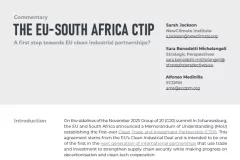
To limit global warming to well under two degrees, the global economy needs to undergo system-wide changes. Finance has a critical role to play.
The finance sector, defined as provider of financial services to actors in the real economy must play a central role in bringing about systemic change and in helping mobilise and shift capital to fully decarbonise the economy. UNEP FI estimates that for full decarbonisation, the world needs investments in the order of 5 to 7 trillion USD per year (UNEP FI). While staggering, tens of trillions of dollars are spent every year on exploration, extraction, refining, and transporting fossil fuels as well as building, selling, installing and using things that burn fossil fuels to generate electricity, transport people and goods. There is enough to invest, but policy makers, investors, asset managers, and financial service providers must move quickly to re-direct financial flows towards a massive expansion of renewable energy, electrification of other end-use sectors, and improved efficiency. Though this shift has started, it must go further and faster. It also requires a closer and better coordination between finance and environment ministries on this topic, and financial supervisory and regulatory bodies.
While it is increasingly clear what real world economic policies foster a country’s attractiveness for climate compatible investments, much less attention has so far been placed on the financial sector and how financial sector reform impacts climate compatible financial decision making at more broadly. At the same time, the rules and information which govern financial decision making have wide implications on whether or not countries fully decarbonise.
Role of financial sector in achieving the Paris Agreement goals
It is the role of the financial sector to efficiently allocate capital. Policy makers have a responsibility to ensure financial stability and safeguard people’s savings. Climate change poses a direct threat to these goals, as Mark Carney and others have prominently pointed out. Fully accounting for the threat of climate change, on the other hand, would not only lead to fewer stranded assets and lower GHG emissions in real economy sectors, but also enhance resilience and improved economic returns. However, in a large number of countries, various barriers still prevent this from happening including a lack of disclosure of climate risks and underdeveloped regulatory frameworks.
Current inaction continues to lead to inefficient capital allocation, undermining efforts towards decarbonisation and financial stability
Ambitious real economy sector policies cannot address the issue of financial sector externalities – but they are key for financial regulators and market participants to understand the direction of travel. At the same time, financial incentives targeting specific sectors (e.g. carbon taxes, feed-in-tariffs) provide important signals to financial market participants. However, vested interests and inertia mean that they are not sufficient to fully decarbonise the economy without a broader reform of the finance sector.
One of the main obstacles to increase climate compatible investments is the prohibitive cost of capital in many developing countries which often means that investments will not be made or not at the scale required. The cost of capital is largely determined by perceived investment risks, but financial actors today have largely not yet understood and internalised physical climate risk considerations, nor do they fully understand long-term transition risks and how may lead to financial instability.
Being able to understand and price in risks efficiently requires a thorough understanding of what climate change means for the financial sector and the larger real economy, and a clear understanding of how best to make the most of the opportunities that a transition can bring.
The need for reform
There are various reforms across four main financial policy areas that can help the finance sector become fit for purpose. This includes:
- Standards: Climate compatible finance labels and other informational instruments can help to identify which investments unambiguously contribute to decarbonisation. They are also useful to avoid greenwashing and increase overall transparency.
- Prudential regulation: The clarification of fiduciary duties as well as capital and liquidity requirements can help decrease regulatory barriers and increase incentives for the integration of climate considerations into investment and loan decisions. At the same time, prudential regulation can also help address climate compatible finance supply and demand. Climate stress tests can further help financial institutions assess and better prepare for climate shocks.
- Institutional regulation: Regulations targeting specific financial regulators (including stock exchanges) can help to further encourage different types of financial market participants to manage and report on climate change.
- Disclosure: Mandatory and transparent reporting of emissions covering all emission scopes at investee and financial institution level is important to provide relevant information for informed decision-making in the short and long-turn.
There are some positive developments. More and more countries have started to understand the importance and urgency of the issue. This includes:
- Recent efforts by the EU Commission’s action plan on financing sustainable growth, and proposed work in the US by the Secretary of the Treasury, Janet L. Yellen.
- The G20 has recently relaunched its G20 Sustainable Finance Study Group and elevated it to a Working Group.
- The Network for Greening the Financial System (NGFS) which aims at sharing best practice and mobilizing mainstream finance to support the transition towards a sustainable economy.
- The 26 members of the IFC-hosted Sustainable Banking Network, which brings together financial sector regulatory agencies and banking associations from emerging markets, have put forward policies to advance sustainable finance practices in their countries.
- The Central Bank of Brazil put forward a proposal in April this year to advance sustainable finance practices within the country. The proposed changes include, among others, a requirement for financial institutions to incorporate a climate dimension into their socio-environmental responsibility policy and public disclosure of how climate change is incorporated into their risk and management processes.
The NewClimate finance teams works to understand the interplay between climate and finance and supports policy makers in setting the right framework to shift financial flows to a Paris-aligned pathway.
At NewClimate, we work on a number of projects that also cover the topic of financial sector reform:
“Enabling conditions for investment in the transition to a low-carbon society in Latin American countries” - We will soon publish the first of a number of Annual Investment Report (first one forthcoming). This year’s report focuses on the policy landscape needed to enable the transition, identifying key policies at a sectoral and national level to support investments towards a zero emissions pathway in Argentina, Brazil, and Peru. The identification and management of climate-related risks in the finance sector is primordial but is still at a relatively early stage - worldwide and in Latin America.
“Strengthen national climate policy implementation: Comparative empirical learning & creating linkage to climate finance – SNAPFI” – As part of this project, we looked at financial sector reform and how technical assistance can foster a more sustainable financial market in China and Kenya.






